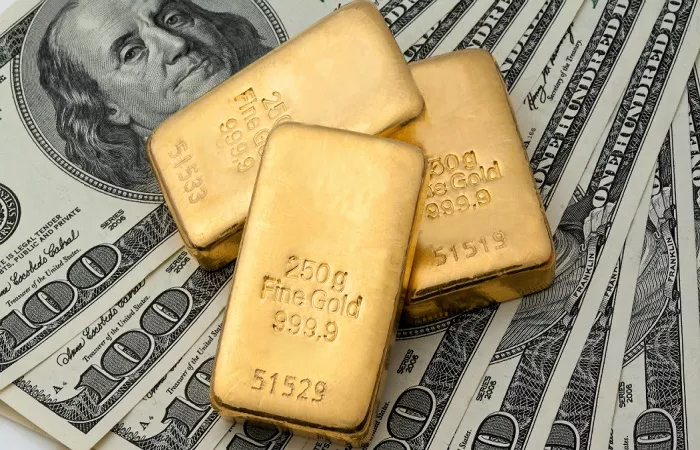Gold prices have reached unprecedented heights, with futures crossing the Rs 1 lakh per 10 grams mark for the first time ever. This surge, which marks a significant milestone for the precious metal, is the result of a confluence of factors, including rising geopolitical tensions, global trade uncertainties, and growing concerns about U.S. monetary policy.
On the Multi Commodity Exchange (MCX), the August delivery contract of gold surged by Rs 2,048, or 2.1%, during mid-session trading, reaching the record-breaking level of Rs 1,00,000 per 10 grams. This sharp rise continued the bullish trend for gold, which has now posted gains for four consecutive sessions. The yellow metal then traded at Rs 99,790 per 10 grams, an increase of Rs 1,838, or 1.88%, with substantial open interest in the market.
Other gold futures contracts also reached new highs, with the October contract climbing by Rs 2,016, or 2.04%, to touch Rs 1,00,500 per 10 grams. The June contract, which recorded the highest trading volume, rose by Rs 2,079, or 2.14%, to Rs 99,358. This ongoing rally in gold futures highlights a growing demand for the metal as a safe-haven asset amid rising global uncertainties.
The catalyst for this surge appears to be a combination of factors. The U.S. trade war, particularly tensions between the U.S. and China, has led to fears of a potential global economic slowdown. In addition to these trade concerns, U.S. President Donald Trump’s repeated criticism of the Federal Reserve has added further volatility to global markets. Trump has pushed for aggressive rate cuts, with some analysts speculating that the President might be considering reforms to the Federal Reserve, potentially shaking investors’ confidence in the U.S. Dollar and increasing demand for gold.
Saumil Gandhi, Senior Research Analyst (Commodities) at HDFC Securities, pointed out that the rise in gold prices has been exceptional over the years. In 1990, gold was priced at a mere Rs 3,200 per 10 grams, but by the end of 2024, prices had skyrocketed to Rs 77,913 per 10 grams. The compounded annual growth rate (CAGR) for gold over this 34-year period has been remarkable, and the current surge further underscores the long-term trend of rising demand for gold, particularly in times of economic uncertainty.
One of the primary drivers of the recent price jump has been the global trade war, which continues to fuel concerns about inflation, economic slowdown, and market instability. Investors are flocking to gold as a hedge against these uncertainties. Meanwhile, the uncertainty surrounding the future direction of U.S. monetary policy, especially given Trump’s repeated calls for rate cuts, has caused additional volatility in financial markets. With a weakening U.S. Dollar and falling interest rates, the opportunity cost of holding non-yielding assets like gold diminishes, further boosting its appeal.
Furthermore, demand for gold in key markets, particularly China and India, continues to strengthen. In China, gold investment has been surging, with investors flocking to gold-backed exchange-traded funds (ETFs) and other precious metal assets. The World Gold Council (WGC) has reported that Chinese gold ETF holdings have more than doubled since March 2024, driven by retail and institutional investors seeking to safeguard their wealth amidst economic and trade uncertainty. China’s growing demand for gold has also impacted global pricing, with premiums on gold shipments to the country remaining significantly higher than typical levels.
In India, gold prices have reached near-record levels, and despite the festive season providing some support, retailers are facing challenges due to high import duties and the growing cost of gold. Analysts expect further demand during upcoming festivals, although concerns about the sustainability of the price rally persist. Gold’s popularity remains resilient in these markets, driven by its perceived value as a long-term store of wealth.
As gold prices continue their climb, investors are keeping a close eye on the broader economic landscape. A significant development will be the U.S. Federal Reserve’s next steps. The CME Group’s FedWatch Tool suggests that traders are pricing in the possibility of a 25-basis-point rate cut in June 2025, followed by additional cuts later in the year. This expectation has contributed to the weakening U.S. Dollar, reinforcing the appeal of gold.
For gold investors, while the current bullish trend remains strong, caution is advised due to the overbought conditions seen in the market. Technical indicators, such as the Relative Strength Index (RSI), suggest that gold may be entering overbought territory, and some market analysts are predicting that a consolidation or pullback could be on the horizon. This presents an opportunity for investors to either take profits or wait for a more favorable entry point before making new positions.
In conclusion, gold’s price surge to new record highs reflects broader economic concerns, including global trade tensions, uncertainties around U.S. monetary policy, and continued geopolitical instability. As these issues persist, demand for gold is likely to remain strong, making it a top choice for investors seeking a safe-haven asset. Whether the rally will continue unabated remains to be seen, but for now, gold appears to be in a strong upward trend, driven by a complex mix of market forces.
Related topics:
- What is the Value of 18K Gold?
- Why Does Gold Price Increase During War?
- What is the Best Price Being Paid for Gold Sovereigns?


